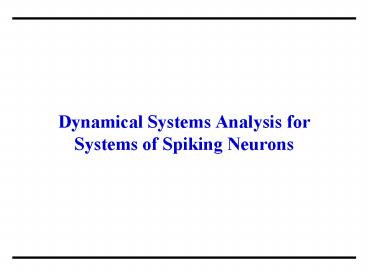Dynamical Systems Analysis for Systems of Spiking Neurons - PowerPoint PPT Presentation
Title:
Dynamical Systems Analysis for Systems of Spiking Neurons
Description:
Resting Potential VRest assumed to be 0. ... Spike generated when V reaches VThreshold ... (Area V1 of Macaque Monkey) Source: Dr. Wyeth Bair, CNS, NYU ... – PowerPoint PPT presentation
Number of Views:66
Avg rating:3.0/5.0
Title: Dynamical Systems Analysis for Systems of Spiking Neurons
1
Dynamical Systems Analysis for Systems of Spiking
Neurons
2
Models Leaky Integrate and Fire Model
- CdV/dt -V/RIsyn
- Resting Potential VRest assumed to be 0.
- CR Membrane time constant (20 msec for
excitatory neurons, 10 msec for inhibitory
neurons.) - Spike generated when V reaches VThreshold
- Voltage reset to VReset after spike (not the
same as VRest) - Synaptic Current Isyn assumed to be either delta
function or alpha function.
3
Models Spike-Response Model
Observation The L-IF-model is linear CdV1/dt
-V1/RI1syn CdV2/dt -V2/RI2syn Cd(V1V2)/dt
-(V1V2)/RI1synI2syn Why not simply take the
individual effect of each spike and add them all
up? Result The Spike response model. V(t)effect
of previously generated spikes by neuron
sum over all effects generated by spikes that
have arrived at synapses
4
Background The Cortical Neuron
Output
Input
Threshold
- Absolute Refractory Period
- Exponential Decay of effect of a spike on
membrane potential
Time
5
Background Target System
Neocortical Column 1 mm2 of the cortex
Recurrent network 100,000 neurons 10,000
synapses per neuron 80 excitatory 20
inhibitory
Output
Recurrent System
Input
6
Background The Neocortex
(Healthy adult human male subject) Source Dr.
Krishna Nayak, SCRI, FSU
7
Background The Neocortex
(Area V1 of Macaque Monkey) Source Dr. Wyeth
Bair, CNS, NYU
8
Background Dynamical Systems Analysis
- Phase Space
- Set of all legal states
- Dynamics
- Velocity Field
- Flows
- Mapping
- Local Global properties
- Sensitivity to initial conditions
- Fixed points and periodic orbits
9
Content
- Model
- A neuron
- System of Neurons Phase Space Velocity Field
- Simulation Experiments
- Neocortical Column
- Qualitative Characteristics EEG power spectrum
ISI frequency distribution - Formal Analysis
- Local Analysis Sensitivity to Initial Conditions
- Conclusions
10
Model Single Neuron
Potential Function
Each spike represented as How long since it
departed from soma.
11
Model Single Neuron Potential function
12
Model System of Neurons
- Point in the Phase-Space
- Configuration of spikes
- Dynamics
- Birth of a spike
- Death of a spike
13
Model Single Neuron Phase-Space
14
Model Single Neuron Phase-Space
Theorem Phase-Space can be defined
formally Phase-Space for Total Number of Spikes
Assigned 1, 2, 3.
15
Model Single Neuron Structure of Phase-Space
- Phase-Space for n3
- 1, 2 dead spikes.
16
Model System of Neurons Velocity Field
17
Simulations Neocortical Column Setup
- 1000 neurons each connected randomly to 100
neurons. - 80 randomly chosen to be excitatory, rest
inhibitory. - Basic Spike-response model.
- Total number of active spikes in the system ?EEG
/ LFP recordings - Spike Activity of randomly chosen neurons ?Real
spike train recordings - 5 models Successively enhanced physiological
accuracy - Simplest model
- Identical EPSPs and IPSPs, IPSP 6 times stronger
- Most complex model
- Synapses Excitatory (50 AMPA, NMDA), Inhibitory
(50 GABAA, GABAB) - Realistic distribution of synapses on soma and
dendrites - Synaptic response as reported in (Bernander
Douglas Koch 1992)
18
Simulations Neocortical Column Classes of
Activity
Number of active spikes Seizure-like Normal
Operational Conditions
19
Simulations Neocortical Column Chaotic Activity
T0
T1000 msec
Normal Operational Conditions (20 Hz) Subset
(200 neurons) of 1000 neurons for 1 second.
20
Simulations Neocortical Column Total Activity
Normalized time series Total number of active
spikes Power Spectrum
21
Simulations Neocortical Column Spike Trains
Representative spike trains Inter-spike
Intervals Frequency Distributions
22
Simulations Neocortical Column Propensity for
Chaos
ISIs of representative neurons 3 systems
70,80,90 synapses driven by pacemaker
23
Simulations Neocortical Column Sensitive
Dependence on Initial Conditions
T0
T400 msec
Spike activity of 2 Systems Identical Systems,
subset (200) of 1000 neurons, Identical
Initial State except for 1
spike perturbed by 1 msec.
24
Analysis Local Analysis
- Are trajectories sensitive to initial conditions?
- If there are fixed points or periodic orbits, are
they stable?
25
Analysis Setup Riemannian Metric
26
Analysis Setup Riemannian Metric
- Discrete Dynamical System
- Event ? Event ?Event.
- Event birth/death of spike
27
Analysis Measure Analysis
Death of a Spike
PI
Birth of a Spike
28
Analysis Perturbation Analysis
29
Analysis Perturbation Analysis
30
Analysis Local Cross-Section Analysis
AT
B
C
31
Analysis Local Cross-Section Analysis
32
Analysis Local Cross-Section Analysis Prediction
33
Analysis Local Cross-Section Analysis Prediction
Neocortical Column
34
Analysis Discussion
- Existence of time average
- Systems without Input and with Stationary Input
- Transformation invariant (Stationary)
Probability measure exists. - System has Ergodic properties.
- Systems with Transient Inputs
- ?
- Information Coding (Computational State vs.
Physical State) - Attractor-equivalent of class of trajectories.































